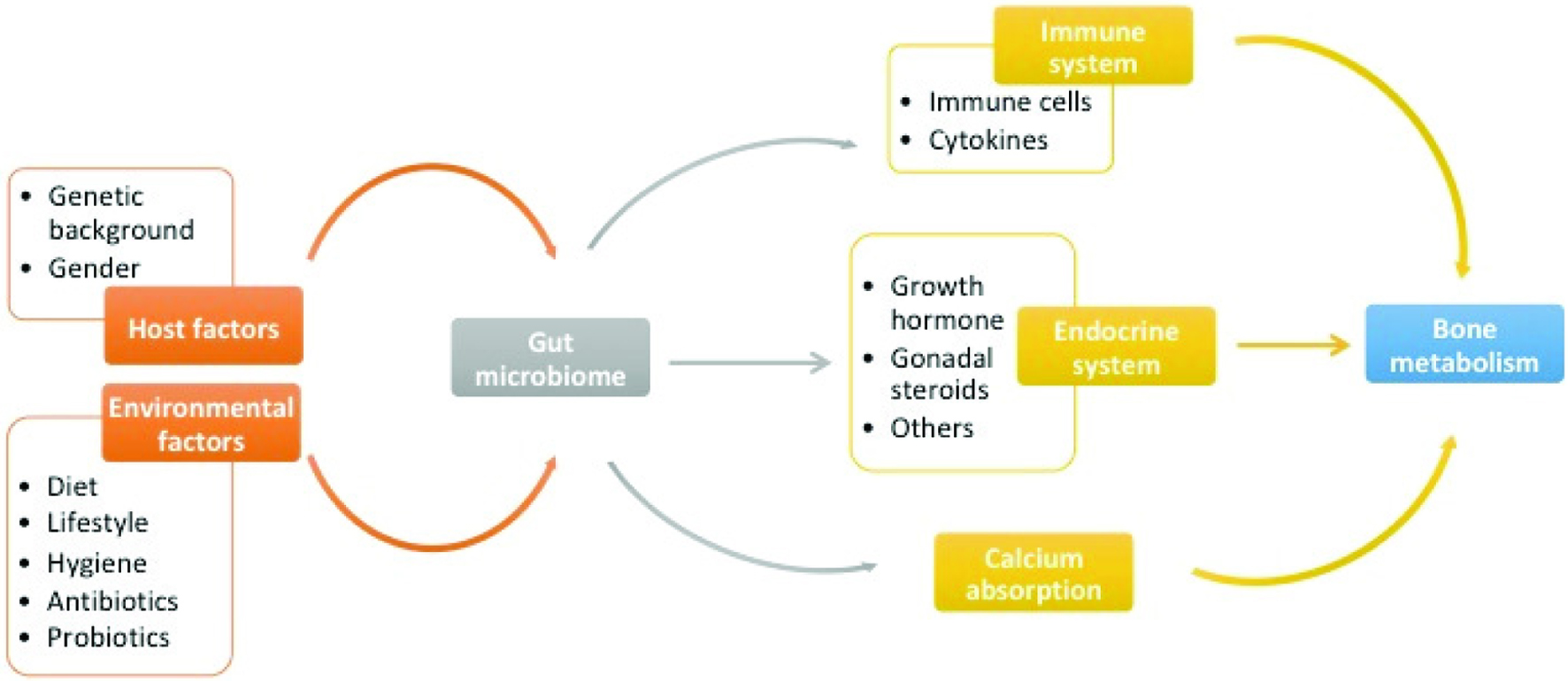| Probiotics |
C57B1/6 mice
Male and female | Treated with Lactobacillus reuteri ATCC PTA 6475 | L. reuteri 6475 treatment increased male trabecular bone parameters in the distal femur metaphysieal regions and the lumbar vertebrae in male mice
L. reuteri 6475 treatment had no effect on bone parameters in female mice | McCabe et al., 2013 |
Balb/c mice
Female OVX | Treated with Lactobacillus reuteri ATCC PTA 6475 | L. reuteri treatment protected OVX mice from bone loss
L. reuteri treatment decreased osteoclastogenesis | Britton et al., 2014 |
B57BL/6N mice
Female OVX | Treated with 1) Lactobacillus paracasei DSM13423; 2) a mixture of L. paracasei DSM13434, L. plantarum DSM 15312 and DSM 15313 | L. paracasei DSM13423 and the mixture treatment protected from OVX-induced cortical bone loss and bone resorption | Ohlsson et al., 2014 |
Balb/c mice
Female with mild inflammatory state induced by dorsal surgical incision (DSI) | Orally supplemented with L. reuteri PTA 6457 | L. eruteri 6457 treatment increased bone density in females but only in those that underwent DSI | Collins et al., 2016 |
BALB/c mice
Male germ-free | Lactobacillus. PlantarumWJL and L. plantarumNIZO2877 were gavage to 8-week-old mice to develop Lactobacillus-monocolonized mice | Reduced femur length, cortical thickness, cortical bone fraction, and the trabecular fraction of the femur in germ-free mice
Lactobacilli promoted juvenile growth | Schwarzer et al., 2016 |
C57BL6/J mice
Female germ-free | Sex steroid deficiency mice treated with Lactobacillus rhamnosus GG, commercial probiotic supplement VSL#3, Escherichia coli and a mutant L. rhamnosus GG | Probiotic treatment reduced bone marrow inflammation and protected against bone loss
nonprobiotic (E. coli and mutant L. rhamnosus GG) treatment showed no protective effect | Li et al., 2016 |
| Prebiotics |
Wistar rat
Female ovariectomized (OVX) | Treated with galactooligosaccharides (GOS) | GOS treatment absorbed calcium more efficiently
GOS showed higher bone (femur and tibia) ash weight and tibia calcium context of OVX rats | Chonan et al., 1995 |
Wistar rat
Male rat | Treated with inulin and resistant starch | Inulin and resistant starch increased the intestinal absorption and balance of Ca and Mg, without altering the plasma level of Ca and Mg | Younes et al., 2001 |
Sprague Dawley rat
Female OVX | Treated with inulin and fructooligosaccharides (FOS) | Inulin and FOS treatment increased bone mineral density, breaking strength, and total calcium
Inulin and FOS treatment inhibited the bone resorption | Zafar et al., 2004 |
Sprague Dawley rat
Male rat | Treated with inulin-type fructans (inulin, oligofructose, fructooligosaccharides) | Inulin-type fructans increased mineral absorption, retention and accumulation in bone in the case of Ca, Mg and Zn | Raschka and Daniel, 2005 |
Sprague Dawley rats
Female OVX | Treated with vitamin D-deficient diet with or without difructose anhydride III (DFAIII) | Vitamin D deficiency decreased Ca absorption and bone mineralization
DFAIII treatment restored the reduction of Ca absorption and femoral Ca | Mitamura and Hara, 2006 |
BALB/c mice
Female | Treated with antibiotics and short chain fatty acid (SCFA) | Antibiotic treatment decreased serum IGF-1 and inhibited bone formation
Antibiotic treatment group supplemented with SCFA restored IGF-1 and bone mass | Yan et al., 2016 |
Human
Postmenopausal women | Supplemented with inulin | Inulin treatment improved mineral absorption and impacted bone turnover | Holloway et al., 2007 |
Human
Postmenopausal women | Treated with 1) milk fermented with Lactobacillus helveticus LBK-16H bacteria, supplemented with 14.5mg/100g of IPP and VPP; 2) normal sour milk fermented with a Lactococcus sp. Mixed culture; 3) orange juice with 14.5mg/100g of IPP and VPP; 4) orange juice with calcium lactate gluconate | L. helveticus fermented milk treatment reduced serum PTH and increased serum calcium | Narva et al., 2004b |
